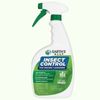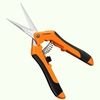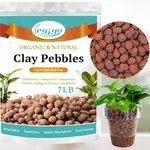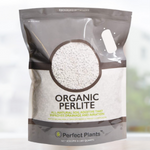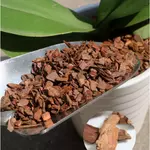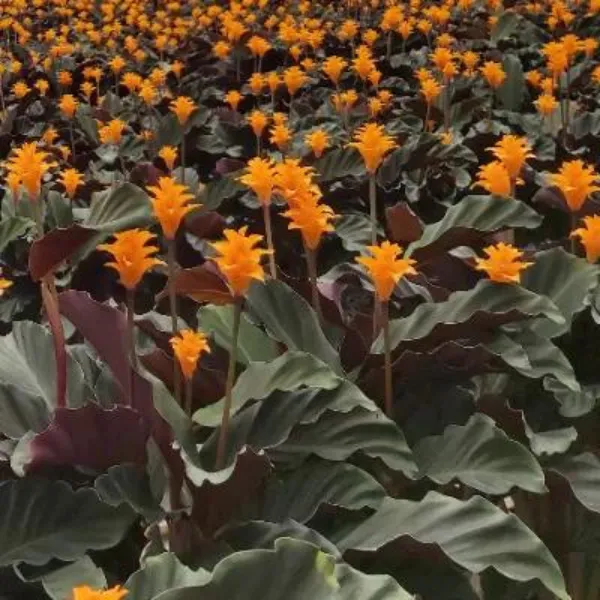Calathea Crocata Tassmania belongs to the family Marantaceae and is distinguished from other Calatheas because of its unique, striking saffron-coloured blooms. Calathea species are famous for their lush green foliage with attractive foliage patterns and burgundy undersides, whereas Calathea Crocata is adored because of its flaming hot, orange-yellow flowers. They are also called the ‘Tassmania’ Plants or Eternal Flame Plant based on the flowering colour and shape. The Eternal flame plant can be a striking, eye-catching addition to your indoor flowering plants. Flowering stems are straight and a little higher than the leaves making flowers prominent from the entire plant.

Tassmania, is endemic to the rainforests of Brazil and Central and South America, making its way to Hawaii in the 1970s. Crocata inhabits the jungle floor under the tree canopy, basking in humidity and warm temperatures and receiving dappled sunlight. Moreover, the purple undersides indicate their tolerance to low light conditions. Mimicking their natural habitat is the key for the Calatheas to thrive and produce healthy, attractive foliage.
Prominent Family Members: Calathea Medallion, Calathea Zebrina, Calathea Lancifolia, Calathea Rufibarba, Calathea Ornata, Calathea Orbifolia, Calathea Warscewiczii
Essential Products
How do you look after a Calathea Crocata?
Calathea Crocata plants love to grow in warm , shaded areas as they are native to the jungles of South America. Being tropical plant, they prefer high humidity, nutrient-rich moist but well-drained soil and temperature ranging from 60 to 80ºF. However, it is a forgiving Calathea and is low maintenance. Water the plant when upper two inches of the soil feels dry. Fertilizing once a month and regular inspection of any pests and diseases would help plant flourishes.

Keep reading the specific details to keep your Tassmania healthy, and thriving and learn all the pro tips and tricks to keep any potential problems at bay.

Bringing the Tassmania plant to home
The New Eternal Flame plant can be a carrier of pests and diseases. Isolation is required for two weeks from other indoor plants to protect them from contamination.
Examine the whole plant carefully, especially the leaves, as pests are feeding on the lower side of the leaves. Furthermore, even a single minute brown patch or hole on the leaves might indicate pests. For precautionary measures, apply neem oil or spray the pesticide on the leaf surface and if the pest’s invasion is too strong, cut the leaf from the plant.
After two weeks, if the plant doesn’t show any pests and disease, place it in a bright, humid area among other plants to thrive happily indoors.

How often does the Calathea Crocata Tassmania flower?
The Eternal Flame plant is also famous as a Flame plant having flowers that bloom like a flame. Crocata is prized for their astounding flame orange flowers unlike insignificant flowers of it cousin Calatheas. The plant blossoms throughout the year off and on; however, it displays flame tip flowers more frequently in summer.
The Flowering stalk emerges straight from the roots and develops a stunning orange-yellow long flame-shaped flower on the stalk’s tip. The stalk is 2 meters long and is taller than the plant’s foliage, making it prominent from a distance. Calathea flowers live up to three months and decorate indoors with color.
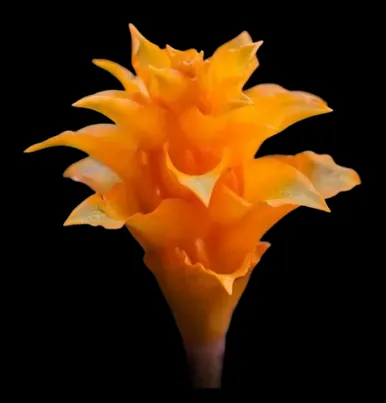
Flower of Calathea Crocata

Calathea Crocata Light Requirements
Calathea Crocata Flame plant hails from the South American rainforest, thickly populated with tall and dense trees. These trees form a thick canopy that doesn’t let the sunlight pass. Under the shades of these trees, low-light loving plants flourish, and Eternal Flame Calathea is one of them.
If you want your Calathea to look fresh and healthy and bloom in the season, put it in a shady place with less exposure to light. The best place in the home is near the north-facing window with indirect medium light. You may place the plant in the south-facing window, but you will need to use blinds or curtains that diffuse the direct sunlight.
Plant exposed to intense light starts fading the lush green color of the leaves and crispy brown edges. However, in winter, Crocata requires more indirect light than in summer.
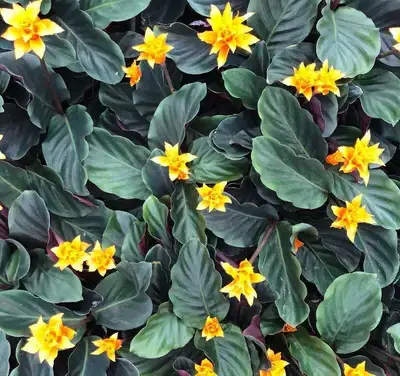

Humidity and Temperature for Flaming Tip Flowers
Flame Tip Flowers are native to the rainforest of South America. The average rainfall is 24 to 56 inches, and humidity levels are quite high because of excessive rain throughout the year.
‘Tassmania’ plants like other Calatheas Louisae and Musaica also require more than 50 % humidity in their growing surroundings. To check the necessary moisture in the atmosphere, use a hygrometer and the best humidifier appropriate for plants to overcome the low humidity problem.
Low humidity symptoms are brown edging of the leaves, indicating using a humidifier or misting with distilled water on alternative days. Misting can be effective in some cases; however, if water droplets remain on leaves for long, it might invite fungal disease to attack. Therefore we recommend wiping out the leaves after misting to eliminate the chances of fungal disease development.
Flame flowers require extra care when it comes to misting. Please do not mist the flowers directly; therefore, cover the flowers while misting.
You can make a temporarily homemade humidifier by using a pebble tray and placing the pot over the top of pebbles. Fill the pebble tray with water ensuring the top water level remains lower than the pot bottom. It’s easy to make, simple, and economical too.
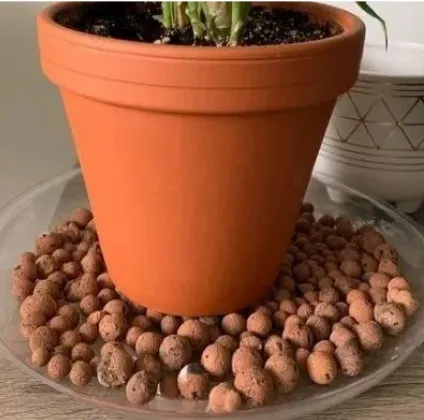
Homemade Humidifier
The perfect temperature for the flame plant growth is 65 to 80 º F. Plant thrives well indoors in warm conditions. In addition, the plant doesn’t stand extreme temperature changes, and a sudden drop or rise in temperature affects its growth and freshness.
The curling of the leaves indicates temperature around Calathea is not ideal. In winter and summer, indoor cooling and heating ducts near Calathea may harm its leaves. Please avoid putting them near those locations in the home.

How do you water Calathea Crocata?
Eternal Flame plants thrive best with a regular water supply and moist soil. However, its water requirements vary with the seasons. In Spring and summer, it requires more frequent water than winter. It prefers to be a little bit moister, but you still have to let it dry out a bit, maybe up to the knuckle in the pot. It would help if you let it dry out a bit and then water it again but don’t let it dry out completely as it’s not going to appreciate that.
Calathea Crocata remains happy in moist soil. The best way to determine the moisture is to insert your fingers in the soil and if upper two inches of soil feels dry , your plant needs watering. Moreover, using a moisture meter or moisture sensor is also helpful in determining the soil dryness.
Usually watering once a week or every ten days is required in the growing season, starting from early Spring to late summer. When it comes to water type, rainwater is best, but if it’s difficult to get rainwater, then distilled or filtered water are other options. Calathea species are very sensitive to chemicals present in tap water that can burn the leaf and affect overall plant health.
If you can get reverse osmosis or demineralized water, your plant will grow better than watering with hard water. Moreover, if you live in an area with soft water, using it from the tap is not harmful. Remember, Crocata won’t appreciate hard water, and you may get browning on the leaf tips as a result.
Watering your plant with fish tank water is also beneficial because it’s already going to be warmer, than the water out of the tap will have some dissolved fish waste in it, which will be like a weak fertilizer.
Following water types must be avaoided fro ‘Tassmania’ plants
- Hard water
- Fluoridated water
- Cold water
Overwatering will make the soil soggy, and roots will be exposed to water for a long period and become prone to fungal diseases. In addition can also cause root rot, wilting, lifeless leaves, and color loss. In winter, the soil remains moist for a long period due to low temperatures and dormancy period. Therefore, water the plant every other week depending on soil moisture.
Whereas in Summer, your plant may need frequent watering depending on the heat and light it is exposed to and the type of soil used. If your plant is wilting and leaves are developing brown edges and crispiness, probably the plant is not getting enough water. Make a routine for watering the Eternal Flame plant to avoid these problems.

Calathea Crocata Soil Requirements
Generally, the Calathea species live in acidic soils with their PH value near 6.5. For the best growth, grow your Calathea Crocata in a fertile non-compact potting mix comprising peat. Please do not use a regular potting mix or garden soil because it retains too much water and is compact. Calathea roots likes to breath but wants to stay moist at the same time.
The plant originates from the wild forests. They live in the debris and dead/fallen leaves; therefore a well-draining and airy soil with the ability to retain moisture but well draining, will be most suitable for Calathea Crocata.
If you want to make your potting soil, use 25% peat and 25% compost/potting mix , 20% perlite , 20% Orchid Bark , 10% charcoal and some organic matter or worm castings to form a blend which is chunky and nutrients rich.
Moreover, if you want all the hassle and want a ready made well draining potting mix , we recommend checking African Violet potting mix or Fox Farm Ocean potting mix . These mixes are chunky and well draining.
Related Products
Products | Name | Check Price |
Organic Perlite for Plants | ||
WONDER SOIL Organic | ||
Orchid Potting Bark Mulch |

Pruning of the Flame tip plant
Pruning is very important in keeping your plant healthy and maintaining its beauty. The pruning process involves the removal of damaged or sick parts of the plant. The Calathea Crocata requires less pruning; however, if the leaves are infected, change their color or die naturally. You will need to remove the leaf from the stem and dispose of it. Once the flower has stopped blooming, remove the stalk of the dead flowers from the plant.
Do not forget to sterilize the shear before pruning. You can sterilize the tool by cleaning them using alcohol-based sanitizers or detergents. Make sure the tools are sterilized and dry before use. This precaution is vital because the infection can spread among the plants through tools.

Fertilizer
Flame plant Flower does not require a lot of fertilizing. However, if you fertilize them every month during the growing seasons from Spring to summer, it may provide you with gorgeous blooms. The plant slows down its growth in winter, so there is no need to fertilize it during that period.
Lush green leaves with flowers
You must fertilize the Calathea Crocata with a stable Nitrogen, Phosphorous, Potassium fertilizer with the NPK ratio of 10-10-10. Mix the fertilizer with water to make a dilute solution that soaks through the soil. Always make certain to follow the instructions written on the fertilizer packet.
In addition, over the period, the fertilizer salts will accumulate in the soil, and this is not an ideal growing condition for the Eternal Flaming Plant. To keep your plant safe, flush the soil with a gentle stream of water every few months, and the salts will percolate in the soil with the water and leave through the drainage hole.
You may use the fertilizers available in a granular form such as slow release fertilizer Osmocote . You can spread the granules on the topsoil, and the nutrients will penetrate the soil every time you water the plant. Slow release fertilizers protects your plant from over fertilization and would be great to start with if you are new to gardening.
Avoid over-fertilization because it can lead to catastrophic results for the plant such as foliage burn.
If you see any of these signs anywhere on the plant, take immediate action, flush the soil thoroughly with water, and stop fertilizing.

Repotting of Flame Plant
You can keep a small Calathea Crocata in the same pot; however, you may need to repot the plant after two years. Over the period, roots grow, and the plant will become root-bound. A root-bound plant will suffer from stunted growth, lack of soil and nutrients availability and the tangles roots may block the pot drain hole, causing water-logging.
Following are the sign indicating the Calathea Crocata requires a new pot:
The new pot shall be around two sizes bigger than the older pot providing enough space to grow. However, do not select a considerably bigger pot, or the plant can become the prey of root rot and overwater. The following are the steps to guide you to repot the plant.

Propagation of Calathea Crocata
Plant propagation is growing the specific cultivar or species through seeds, root division, or stem cuttings. The most recommended time for propagation is when the plant is growing during Spring and Summer as the pant is active and can tolerate the stress.
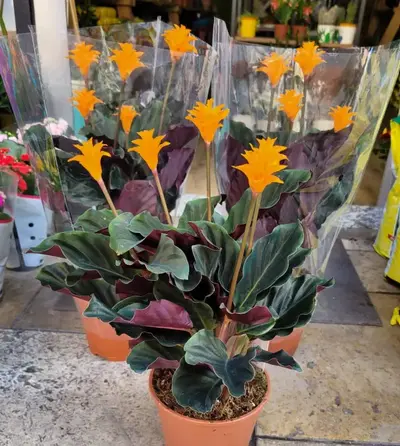
Germinating seeds
Propagating through seeds is relatively time taking and less successful. To propagate through seed, moisten the seeds and plant them in propagation trays in a greenhouse. It will help to cover the propagation tray with a polythene bag to create high humidity. Place the tray in bright indirect light. Once you notice the first shoots, young plants can be transplanted into separate pots.
Rhizome Division
Calatheas aren’t the ones you can take a cutting from and put it in water to propagate. In contrast, they’re propagated by root or offshoot division which means as they grow bigger, when you repot the plant, you can take a clump out from them and put it in a separate pot, and then that will grow on again.
Calathea species grow rhizomes horizontally which form small buds on topsoil, extending into slips called offshoots. The rhizomes develop roots below the offshoots, making them ready to plant separately. In a nutshell, while propagating the Calathea Crocata through roots, you are dividing it down into smaller clumps and repotting them into separate containers.
If you look closer at your Calathea Crocata, many of these plants often have several smaller clumps put together anyway. So, if you don’t mind a smaller plant, you could take this out of its pot and make more than one plant.
To propagate the Calathea Crocata plant, uproot the plant from the current pot. Brush off the soil from the root ball to better grip the roots. Carefully detach the offshoots from the leading root ball using a sharp knife or scissors. Please ensure that the recent shoot contains a few healthy leaves and some roots. Plant the shoot in a new pot with fertile, damp soil at the same depth they were before to grow into new Eternal Flaming plants. Place the pots in a warm, humid place with low light exposure.
Once you notice new growth on the shoots, it means you have successfully propagated the plant.
Rooting cuttings
If the offset doesn’t have enough roots, you can root the cutting in water to grow roots. Once you notice enough roots, you can put the cutting in a well-draining potting mix.

Is the Calathea Crocata Poisonous?
Calathea Crocata leaves and blooms leaves are immensely appealing not only for human beings but also for animals. Kids and animals alike may wish to play with the soft leaves and flowers of the Eternal Flame Plant. Nevertheless, you shall not bother with it as the Calathea Crocata plant is completely safe, non-toxic, and postures no threat to pets as well as youngsters.

Pest And Disease Problem
The bugs and parasites usually live on the lower surface of the leaf by making colonies. They feed on the leaf sap, and intense attacks can weaken or even cause the death of the plant. You shall take immediate action to control the pests’ spread before moving to the other indoor plant collection.
Calathea Eternal Flame plant is usually affected by the two pests
Spider mites
Spider mites are tiny spiders that live in colonies and usually makes white silky webs underneath the leaves. If the plant is under intense attack from spider mites, tiny holes will appear on the leaf blade. Additionally, you can identify spider mites by the web they made to cover the leaf.
Mealybugs
Mealybugs are also tiny insects and resemble scale insects, and they attack the newly formed shoot and stem. Visually, mealybugs colonies look like white cotton mass sticks on the recently developed shoot or stem.
To get rid of these two pests you can use any insecticidal soap or spray Captain Jack’s Dead Bug Brew. Moreover, we highly recommend a mixture of dish washing soap and water to spray thoroughly on the foliage. Wipe off the leaves after 30 to 40 minutes and continue spraying in the manner until these pests are eliminated.
Calathea Eternal Flame plant loves to flourish in humid air, which may invite fungal disease and a few bacterial diseases.
Pseudomonas leaf spot
These are water-filled lesions that develop on the plant leaf surface, usually in black or blackish-green in color. They can easily be cured by spraying copper-containing fungicides.
Pseudomonas blight
This infection attacks the water-filled areas and affects the leaf vein. Pseudomonas blights are badly infectious, spread quickly, and turn the leaf into like brown paper. The bad news is that the sick leaves can’t be cured. The only way to secure the plant is to remove the infected leaf and dispose of them.
Alternaria leaf spot
These are brown or yellow spots that develop on the leaves in circles. Usually, if leaves remain wet for a long period due to misting, invite Alternaria fungus to attack the plant. Copper-based fungicides are useful for controlling this disease.
Fusarium wilt
Fusarium Wilt is a fungal disease originating in the soil that affects the roots and stems. Plant leaves start getting yellow and later wilting occurs. To overcome this problem, remove the plant from the pot, wash the roots, and repot the plant in new sterilized, moist potting soil. Use several weeks of copper-based fungicides to eliminate the further spread of the infestation
Shedding of Flower buds
Drafts and sudden temperature changes might stress Calathea Crocata and the buds and leaves of the calathea begin to dry, resulting in flower shedding.
Crispy leaves tips
Lack of humidity affects the leaves of the plant. Irregular watering or lack of humidity causes the tips of the leaves to turn crispy, meaning the air and soil need to be moistened.
Superstitions
It is believed that Calathea Crocata Tassmania can bring harmony and love into the house like Budha’s hand plant, which is believed to bring fortune. Therefore, people often buy Tassmania plants to create a calm and tranquil atmosphere.

Common Queries
Why are my plant leaves dying on the edges?
The browning or dying of the Calathea Crocata leaves edges mostly happens for two reasons. Either the plant is not getting enough humidity or excessive minerals or fertilizer in the soil. Please monitor the humidity in plant surroundings using a hygrometer and take necessary action to elevate the humidity levels if found less.
You can use a humidifier to eliminate the root cause effectively. If indoor humidity levels are acceptable (50 – 60%), excessive minerals are the probable cause. Stop feeding the plant with fertilizer and flush the plant-soil to remove the extra minerals to overcome the issue. Your tap water may contain a higher amount of chlorine, fluorine, and other minerals; water the plant with rainwater or distilled water if this is the case.
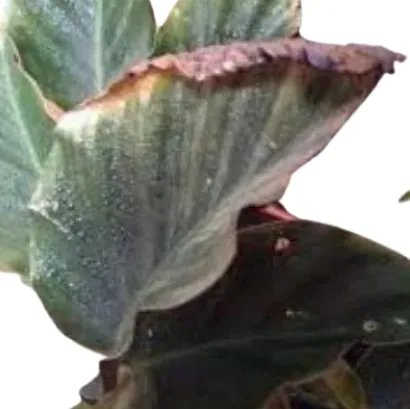
Browning of the leaf
Why are my Eternal Flame plant leaves losing color?
Calathea Crocata leaves can lose color due to multiple reasons. The most common cause is exposure to direct sunlight or lack of nutrients. Relocate the plant to a suitable location with medium to low light and fertilize the plant at a one-month frequency during spring and summer to overcome the issue.



